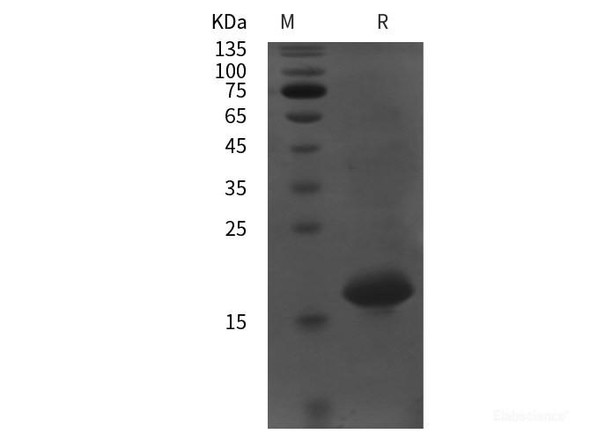Enzymes Recombinant Proteins
Human CASP3 Recombinant Protein (RPPB1472)
- SKU:
- RPPB1472
- Product Type:
- Recombinant Protein
- Species:
- Human
- Uniprot:
- P42574
- Research Area:
- Enzymes
Description
| Product Name: | Human CASP3 Recombinant Protein |
| Product Code: | RPPB1472 |
| Size: | 5µg |
| Species: | Human |
| Target: | CASP3 |
| Synonyms: | CASP3, CPP32, CPP32B, SCA-1, CASP-3, Apopain, Cysteine protease CPP32, CPP-32, Protein Yama, SREBP cleavage activity 1. |
| Source: | Sf9 Insect cells |
| Physical Appearance: | Sterile Filtered colorless solution. |
| Formulation: | CASP3 protein solution (0.5mg/ml) containing 20mM HEPES buffer (pH 7.5), 0.1M NaCl, 1mM EDTA, 20% Glycerol and 1mM DTT. |
| Stability: | Store at 4°C if entire vial will be used within 2-4 weeks. Store, frozen at -20°C for longer periods of time. For long term storage it is recommended to add a carrier protein (0.1% HSA or BSA).Avoid multiple freeze-thaw cycles. |
| Purity: | Greaterthan 90.0% as determined by SDS-PAGE. |
| Amino Acid Sequence: | MSGISLDNSY KMDYPEMGLC IIINNKNFHK STGMTSRSGT DVDAANLRET FRNLKYEVRNKNDLTREEIV ELMRDVSKED HSKRSSFVCV LLSHGEEGII FGTNGPVDLK KITNFFRGDRCRSLTGKPKL FIIQACRGTE LDCGIETDSG VDDDMACHKI PVEADFLYAY STAPGYYSWRNSKDGSWFIQ SLCAMLKQYA DKLEFMHILT RVNRKVATEF ESFSFDATFH AKKQIPCIVS MLTKELYFYH HHHHHH |
| Biological Activity: | Specific activity is� greater than 5,000 pmol/min/ug. One unit will liberate 1 pmoles of Ac-DEVD-AFC to Ac-DEVD and AFC per minute at pH7.5 at 25C. |
Caspase 3 Apoptosis-Related Cysteine Peptidase (CASP3) belongs to the cysteine-aspartic acid protease (caspase) family. Sequential activation of caspases plays a key role in the execution-phase of cell apoptosis. Caspases exist as inactive proenzymes which undergo proteolytic processing at conserved aspartic residues to generate 2 subunits, large and small, that dimerize to create the active enzyme. CASP3 protein cleaves and activates caspases 6, 7 and 9, and the protein itself is processed by caspases 8, 9 and 10. CASP3 is the leading caspase involved in the cleavage of amyloid-beta 4A precursor protein, which is linked with neuronal death in Alzheimer's disease. In addition, CASP3 is involved in the cleavage of huntingtin. CASP3 also cleaves and activates sterol regulatory element binding proteins (SREBPs) between the basic helix-loop-helix leucine zipper domain and the membrane attachment domain. CASP3 initiates cell adhesion in sympathetic neurons through RET cleavage.
CASP3 Human produced in Sf9 Baculovirus cells is a single, glycosylated polypeptide chain containing 256 amino acids (29-277 a.a.) and having a molecular mass of 29.4kDa (Migrates at 13.5-18kDa on SDS-PAGE under reducing conditions). CASP3 is expressed with a�6 amino acid His tag at C-Terminus and purified by proprietary chromatographic techniques.
| UniProt Protein Function: | CASP3: Involved in the activation cascade of caspases responsible for apoptosis execution. At the onset of apoptosis it proteolytically cleaves poly(ADP-ribose) polymerase (PARP) at a '216-Asp-|-Gly-217' bond. Cleaves and activates sterol regulatory element binding proteins (SREBPs) between the basic helix-loop- helix leucine zipper domain and the membrane attachment domain. Cleaves and activates caspase-6, -7 and -9. Involved in the cleavage of huntingtin. Triggers cell adhesion in sympathetic neurons through RET cleavage. Heterotetramer that consists of two anti-parallel arranged heterodimers, each one formed by a 17 kDa (p17) and a 12 kDa (p12) subunit. Interacts with BIRC6/bruce. Highly expressed in lung, spleen, heart, liver and kidney. Moderate levels in brain and skeletal muscle, and low in testis. Also found in many cell lines, highest expression in cells of the immune system. Inhibited by isatin sulfonamides. Belongs to the peptidase C14A family. |
| UniProt Protein Details: | Protein type:Protease; EC 3.4.22.56; Apoptosis; Motility/polarity/chemotaxis Chromosomal Location of Human Ortholog: 4q34 Cellular Component: nucleoplasm; plasma membrane; nucleus; cytosol Molecular Function:peptidase activity; cyclin-dependent protein kinase inhibitor activity; protein binding; cysteine-type endopeptidase activity; aspartic-type endopeptidase activity Biological Process: extracellular matrix organization and biogenesis; nerve growth factor receptor signaling pathway; apoptosis; positive regulation of apoptosis; heart development; negative regulation of activated T cell proliferation; negative regulation of B cell proliferation; regulation of caspase activity; proteolysis; neuron differentiation; extracellular matrix disassembly; sensory perception of sound; B cell homeostasis; positive regulation of neuron apoptosis; response to wounding; erythrocyte differentiation; T cell homeostasis; DNA fragmentation during apoptosis; cell structure disassembly during apoptosis; response to UV; release of cytochrome c from mitochondria; cell fate commitment; negative regulation of cyclin-dependent protein kinase activity; keratinocyte differentiation; neuron apoptosis; induction of apoptosis via death domain receptors; caspase activation via cytochrome c; platelet formation; induction of apoptosis by oxidative stress; response to DNA damage stimulus; negative regulation of apoptosis |
| NCBI Summary: | This gene encodes a protein which is a member of the cysteine-aspartic acid protease (caspase) family. Sequential activation of caspases plays a central role in the execution-phase of cell apoptosis. Caspases exist as inactive proenzymes which undergo proteolytic processing at conserved aspartic residues to produce two subunits, large and small, that dimerize to form the active enzyme. This protein cleaves and activates caspases 6, 7 and 9, and the protein itself is processed by caspases 8, 9 and 10. It is the predominant caspase involved in the cleavage of amyloid-beta 4A precursor protein, which is associated with neuronal death in Alzheimer's disease. Alternative splicing of this gene results in two transcript variants that encode the same protein. [provided by RefSeq, Jul 2008] |
| UniProt Code: | P42574 |
| NCBI GenInfo Identifier: | 77416852 |
| NCBI Gene ID: | 836 |
| NCBI Accession: | P42574.2 |
| UniProt Secondary Accession: | P42574,Q96AN1, Q96KP2, A8K5M2, D3DP53, |
| UniProt Related Accession: | P42574 |
| Molecular Weight: | 277 |
| NCBI Full Name: | Caspase-3 |
| NCBI Synonym Full Names: | caspase 3, apoptosis-related cysteine peptidase |
| NCBI Official Symbol: | CASP3�� |
| NCBI Official Synonym Symbols: | CPP32; SCA-1; CPP32B�� |
| NCBI Protein Information: | caspase-3; CASP-3; CPP-32; apopain; procaspase3; protein Yama; PARP cleavage protease; cysteine protease CPP32; SREBP cleavage activity 1; caspase 3, apoptosis-related cysteine protease |
| UniProt Protein Name: | Caspase-3 |
| UniProt Synonym Protein Names: | Apopain; Cysteine protease CPP32; CPP-32; Protein Yama; SREBP cleavage activity 1; SCA-1 |
| Protein Family: | Caspase |
| UniProt Gene Name: | CASP3�� |
| UniProt Entry Name: | CASP3_HUMAN |






